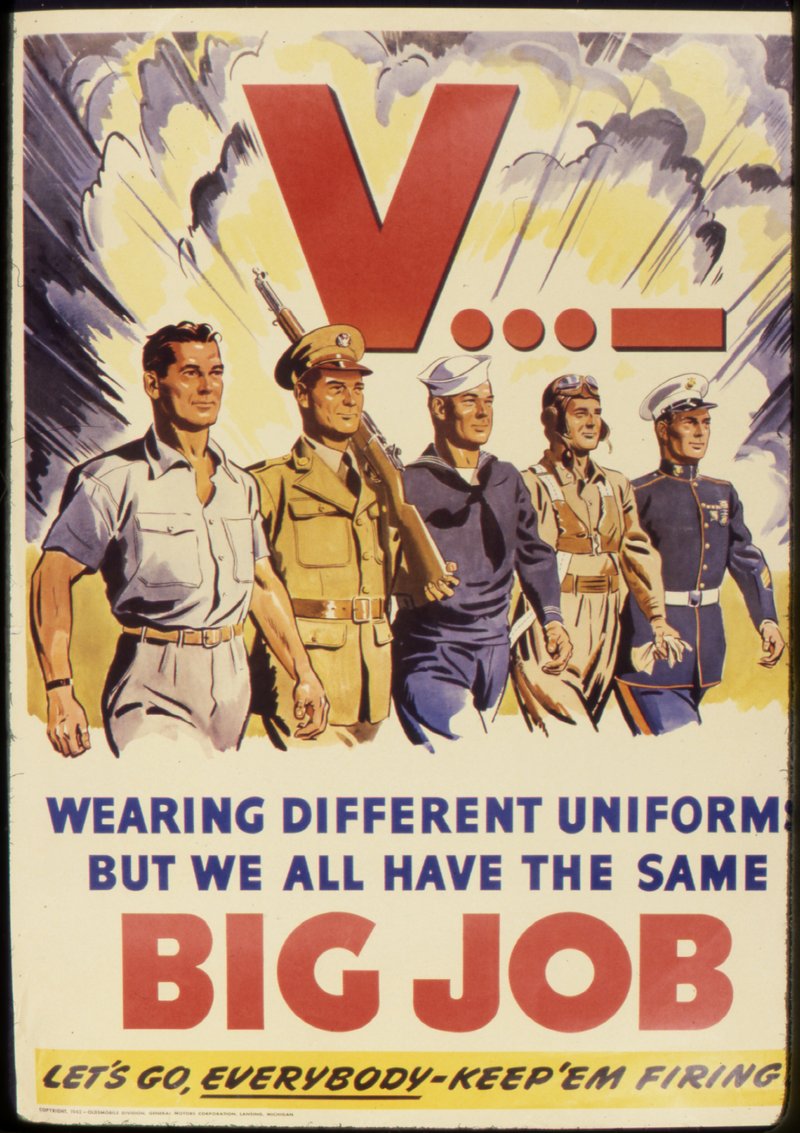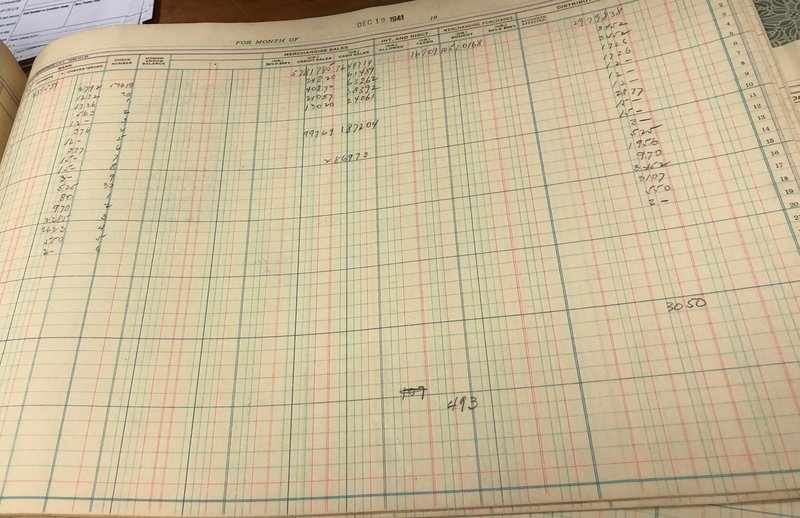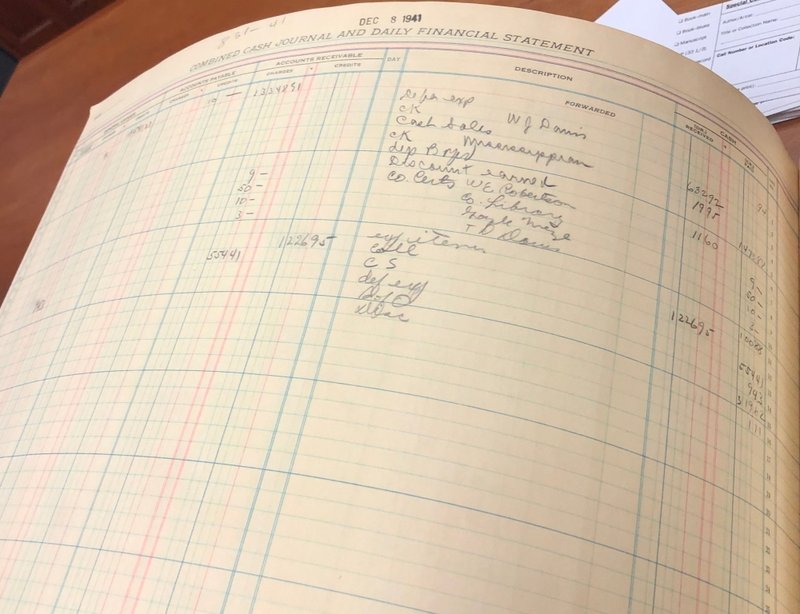Student Work
Economy and Consumer Spending in America During WW II
By: Gunar Robinson

The V-sign (and its morse code equivalent) incorporated on an American propaganda poster for the War Production Board, 1942 or 1943. Photo Public Domain
V is for Victory
The United States of America entered World War II, following the attack on Pearl Harbor, on December 7,1941. On December 8, President Roosevelt ignited the American people by declaring, “No matter how long it may take us to overcome this premeditated invasion, the American people in their righteous might will win through to absolute victory”.[1]These notorious words changed how Americans viewed the war. American attitudes about the war changed radically, (as do) American attitudes about the economy, about giving to the war. The war is not part of the culture; the war is the culture .[2] Campaigns became prominent during the war as the homefront began looking for ways to possibly help the troops overseas. Rationing and frugal spending became normalized for American citizens in day to day life. For instance, campaigns such as “Food for Victory” encouraged the eating of leftovers by citizens and growth of fruits and vegetables for the troops to be helpful. Also, the United States Government started the “Do With Less, So They’ll Have More” which was a program where citizens were rationed sugar, meat, and coffee in order for more supplies to be sent to troops. [3]Rationing and recycling of materials were not the only way citizens helped. Spending changed drastically in the early years of the war. According to the Bureau of Labor Statistics, the consumer spending became more of a “must need” basis instead of a “want” basis. For example, in 1941 citizens spent more on food, while spending less on recreational activities and automobile fuel and repair . Data in the survey also shows a change in percentage of -24.7% in transportation. This shows that citizens were doing their part by carpooling which saves not only gas but reduced the use of rubber which was used for vehicles by the troops.[4] Small states, such as Mississippi, became more than just agricultural dominated states. War related Industries began to pop up across the state like the ammunition plant in Flora and military bases, like Camp Shelby in Hattiesburg.[5] The war helped move Mississippi from a agriculturally dominated economy into more of a industrial and service based economy post-war. In spite of rationing and recycling campaigns, small town department stores, like Neilson’s in Oxford, flourished during the war. In the early days and months of the entrance of the warl, the store did well due to the selling of not only food and other necessities, but becoming a place for western unions, which helped with the transfer of money, and telephone services. With a World War occuring, people of Oxford found an escape through the University of Mississippi like citizens still do to this day. For example, J. Schoeneman purchased a 1941 Ole Miss Football Program from Neilson’s to get his mind off of what was happening in the Pacific and Europe and also support his team.[6] Neilson’s also sold items such as brown shoes, buttons, and food staples, like bread, to people as shown in Ledgers 41 and 42.
Ledger 42, December 19, 1941 from Neilson’s Collection, Department of Archives and Special Collections, The University of Mississippi Libraries.

Ledger 42, December 19, 1941 from Neilson’s Collection, Department of Archives and Special Collections, The University of Mississippi Libraries.

Ledger 42, December 8, 1941 from Neilson’s Collection, Department of Archives and Special Collections, The University of Mississippi Libraries.
[1] Editors, History.com. “Pearl Harbor” History.com (October 29,2009).https://www.history.com/topics/world-war-ii/pearl-harbor.
[2] Michael Morella. How America Changed After Pearl Harbor.” U.S. News & World Report. (January 06, 2012). https://www.usnews.com/opinion/articles/2012/01/06/how-america-changed-after-pearl-harbor.
[3] The National WWII Museum/ New Orleans. “Take A Closer Look: America Goes to War.” https://www.nationalww2museum.org/students-teachers/student-resources/research-starters/america-goes-war-take-closer-look
[4] U.S. Bureau of Labor Statistics. “Consumer Spending in World War II: The Forgotten Consumer Expenditure Surveys : Monthly Labor Review.” https://www.bls.gov/opub/mlr/2015/article/consumer-spending-in-world-war-ii-the-forgotten-consumer-expenditure-surveys.htm.
[5] Sean Farrell. “Not Just Farms Anymore: The Effects of World War II on Mississippi’s Economy.” Gambling in Mississippi: Its Early History | Mississippi History Now. http://mshistorynow.mdah.state.ms.us/articles/247/the-effects-of-world-war-II-on-mississIppis-economy.
[6] Inventory for the Neilson Department Store Ledger Collection (Ledger #41&42). (December 8,1941- February 27, 1942). Department of Archives and Special Collections, The University of Mississippi Libraries.
